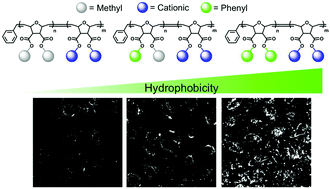Increased hydrophobic block length of PTDMs promotes protein internalization†
Abstract
The plasma membrane is a major obstacle in the development and use of biomacromolecules for intracellular therapeutic applications. Protein transduction domains (PTDs) have been used to overcome this barrier, but often require covalent conjugation to their cargo and can be time consuming to synthesize. Synthetic monomers can be designed to mimic the amino acid moieties in PTDs, and their resulting polymers provide a well-controlled platform to vary molecular composition for structure–activity relationship studies. In this paper, a series of polyoxanorbornene-based synthetic mimics, inspired by PTDs, with varying cationic and hydrophobic densities, and the nature of the hydrophobic chain and degree of polymerizations were investigated in vitro to determine their ability to non-covalently transport enhanced green fluorescent protein into HeLa cells, Jurkat T cells, and hTERT mesenchymal stem cells. Polymers with high charge density lead to efficient protein delivery. Similarly, the polymers with the highest hydrophobic content and density proved to be the most efficient at internalization. The observed improvements with increased hydrophobic length and content were consistent across all three cell types, suggesting that these architectural relationships are not cell type specific. However, Jurkat T cells showed more variation in uptake between polymers than with the other two cell types. These results provide important design parameters for effective delivery of biomacromolecules for intracellular delivery applications.


 Please wait while we load your content...
Please wait while we load your content...